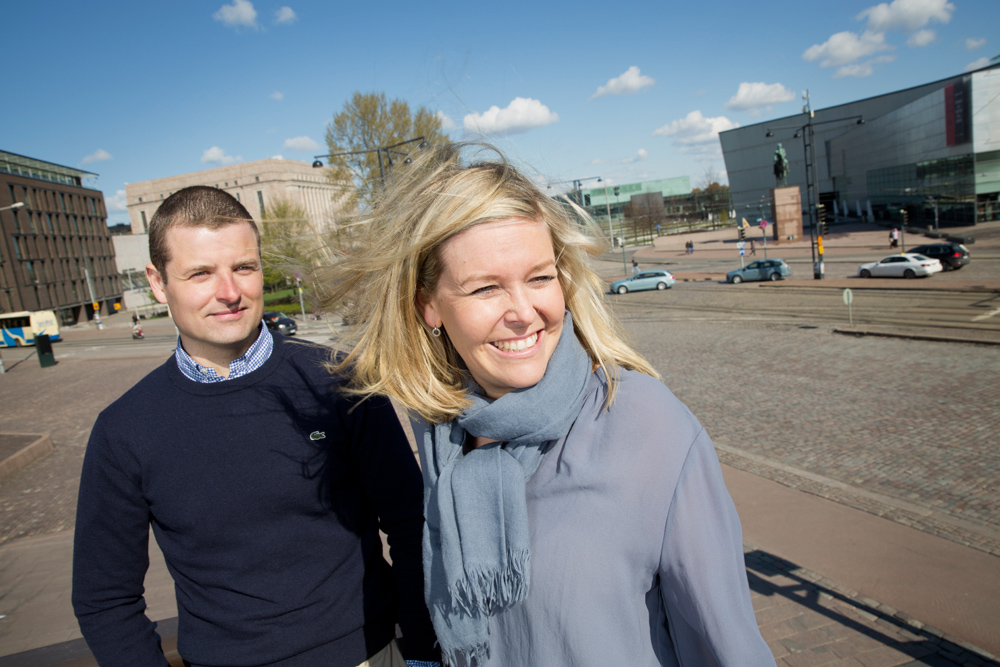City designer of the Design Driven City project Mikko Kutvonen and communications manager Laura Aalto.
Photo Marja Väänänen
By Johanna Lemola
Design Driven City continues the process started in Helsinki’s year as World Design Capital 2012 to build a better city with design.
“We are proof that the World Design Capital project was not a mere love affair but started a true marriage between cities and design,” says Laura Aalto, communications manager for the two-year Design Driven City project envisioned to plant design firmly into city development processes.
In the office, Aalto is flanked by three City Designers. They are professional designers hired by the project to work hand in hand with city staff in selected projects of the four participating cities: Helsinki, Espoo, Lahti and Kauniainen – four of the five cities of World Design Capital Helsinki 2012.
The city projects chosen for Design Driven City are initiated and implemented by the cities, but the City Designers bring to them their design expertise to improve the processes, to introduce user-oriented approaches, and to achieve the best possible outcomes. The City Designers will identify areas where design can be applied and define the ways to apply design.
“Design Driven City will educate city departments and agencies about the possibilities of design and how to use design,” Aalto explains, emphasizing that learning is key to the project. “We strive to integrate design into the processes of solving complex tasks.”
New strength for cities from design
When Helsinki’s World Design Capital project closed at the end of 2012, many questioned, That’s is? Was it just a breathtaking year-long journey with no road ahead?
There had been hundreds of projects and thousands of events. Importantly, city departments and agencies had joined, implementing projects and in ways that they would not have otherwise, in an enthusiastic spirit of achievement never felt before inside the city organization. The City of Helsinki implemented 120 projects during the year.
One of the more enthusiastic City of Helsinki players was the Department of Social Services and Health Care. The department made extensive use of service design in projects ranging from food culture for the elderly to geriatric rehabilitation. Timo Vierelä, a planner at the department, says, “We seized things that we never would have found otherwise, and service design allowed us to focus on the user perspective in a whole new manner. The results were fantastic.” (In an interview for World Design Capital Helsinki 2012)
Inspired by the possibilities of design, the mayors of Helsinki, Espoo, Lahti and Kauniainen did not want to leave it at that. They decided to continue, to make their cities more efficient and better places for citizens – and, ultimately, more competitive – with the help of design. The idea of Design Driven City emerged, focusing only on cities.
Three avenues to integrate design into cities
The City Designers will work with 10–15 city development projects over 2014–2015. To begin with, they help to improve street work sites, create new concepts for youth housing and develop a festival park for Helsinki Festival.
Aalto explains that Design Driven City does not end there. “We also offer the participating cities assistance and counselling. Any city unit with some problem can book a half-day session with us to solve some problem, and we help them to find a solution utilizing design thinking.” Design thinking is a problem-solving protocol that any organization can use to achieve the best possible results.
“Further, we are developing an open network of design agents in the cities,” Aalto continues. “There are already more than 500 such agents, who are city employees with a special interest in design.”
The total funding for Design Driven City over 2014–2015 is 1.5 million euro, about half of which comes from Helsinki and the rest from the Ministry of Employment and the Economy as well as the other three cities.
Cities need design to prosper
Why do cities need design? The Design Driven City project has put the explanation in a nutshell that comprises 10 statements on cities and design.
The statements point out that cities are increasingly complex units, and they need diverse expertise to solve their challenges. The methods of design help cities to find new, even radical ways to operate and to build their future.
Working with important themes
One of the three City Designers of the Design Driven City project is Mikko Kutvonen, hired from among roughly 160 applicants for the position.
He is full of enthusiasm for the project and his assignments. “I feel we’re working with genuinely significant tasks that have a real impact. We are on the front line of city development in this project.”
Kutvonen has started his work for the project focusing on the work sites of Stara. Stara is Helsinki’s in-house construction company and maintenance service provider that takes care of the city’s streets, squares, parks and other public areas.
Stara recognizes that their work sites can be untidy, and often the sites are not very well organized. They realize that the work sites, being highly visible, are part of the overall Stara brand and impact the quality of their urban environments. Stara seeks improvement through a “Tidy work site” programme.
Kutvonen joins the Stara programme in a consulting role, promoting user-oriented design and the use of the tools of service design. The objectives are to produce functional work-site fixtures, professional work-site practices, and a new, attractive work-site appearance. The plan is to produce a set of instructions for work sites by December 2015.



